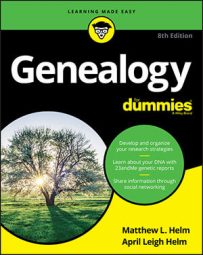How to use Helm's Genealogy Toolbox
If you’re looking for Internet resources on genealogy or local history, you can search for them at Helm’s Genealogy Toolbox by full-text search engine or by browsing categories.
Using the Full-Text Search engine
-
Look for the Genealogy Toolbox Full-Text Search section.
If you need help using the search engine, see the list of tips located just above the search field.
-
Type the first and last name of the individual or type a topic that you’re looking for in the search box and click the Search button.
The Search Results page contains a link to the site, as well as some text from the site that contains your search terms.
-
Click the link to go to the website containing information of interest to you.
Browsing by category
On the home page for Helm’s Genealogy Toolbox, there is a list of categories that you can select to browse resources.
-
Locate the Search Categories table on the home page.
Under the title are several links to topics that may interest you.
-
Click the title of a topic.
A list of resources is displayed.
-
Click the title of a resource that interests you.
The browser will go to the new site where you can find information.
5 genealogy myths exposed
Many family legends have little basis in fact. Because genealogy myths and misperceptions cost researchers time and discourage beginning genealogists, keep in mind these common misconceptions about genealogy when researching your family history.
-
Your complete genealogy is available online.
A number of people have heard that you can go online, click a link, and your entire genealogy appears before your eyes. Although some individuals have posted genealogies that go back centuries, complete genealogies just don’t exist. There’s always a point when you hit the brick wall and can’t find the next ancestor. Beware of anyone who traces their descent all the way back to Adam. There simply isn’t enough evidence to trace back that far.
-
Your family’s surname was changed at Ellis Island.
For those of you who had immigrants that came through Ellis Island, you might have heard that the surname of your ancestor was changed by the immigration officer. The truth is that the passenger lists were created at the place where your ancestor departed and the immigration officers at Ellis Island merely checked off the names from those lists. Most surname changes were due to individuals Americanizing their own names after they immigrated to the United States.
-
You are descended from an Indian Princess.
Although you might have Indian blood coursing through your veins, it isn’t necessarily from a princess. In fact, royalty wasn’t necessarily a concept in most Indian tribes. One way to see if you have Indian blood is to take a DNA test.
-
The courthouse burned, and all records were destroyed.
Although several courthouses have burned over the years, it doesn’t mean that every record was destroyed in the fire. Some records may have been saved or re-created through other records. Church records, family Bibles, wills, and other records can be substitutes for missing courthouse records.
-
Your family legend involves three immigrant brothers.
A lot of family legends revolve around three brothers who immigrated to the United States and then went different directions. This is especially suspicious when the names of the brothers are unknown. Brothers may have immigrated together, but it would have been more likely for them to initially settle in the same area. Then perhaps, later a brother would move to a new place where land was available. And, often, the remaining family would move to the new area after a period of time.
The easiest way to get past the myths is to research based upon what you know from primary sources. You can waste a lot of time trying to prove a family legend, when you could spend the time researching records that will eventually provide evidence as to whether the legend is fact.

